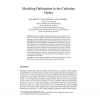Free Online Productivity Tools
i2Speak
i2Symbol
i2OCR
iTex2Img
iWeb2Print
iWeb2Shot
i2Type
iPdf2Split
iPdf2Merge
i2Bopomofo
i2Arabic
i2Style
i2Image
i2PDF
iLatex2Rtf
Sci2ools
SCAI
2008
2008
Modeling Habituation in the Cnidarian Hydra
Abstract. In the design of behavior-based control architectures for robots it is common to use biology as inspiration, and often the observed functionalities of insect behaviors are used as templates. While several robot behaviors have been successfully implemented using this approach, relatively little has been done when it comes to building models of animal behavior using quantitative empirical data. The work reported here uses a system identification approach to model constituent behaviors of a simple biological organism, the hydra. This paper reports on the evolutionary optimization of a behavior module that is based on the hydra's response to mechanical stimuli, which shows habituation. Two model representation schemes were investigated: a recurrent neural network, and a model based on cascaded leaky integrators. Both models were structurally and parametrically optimized by means of an evolutionary algorithm, and it was found that the leaky integrator model performed better o...
| Added | 30 Oct 2010 |
| Updated | 30 Oct 2010 |
| Type | Conference |
| Year | 2008 |
| Where | SCAI |
| Authors | Malin Aktius, Mats Nordahl, Tom Ziemke |
Comments (0)

